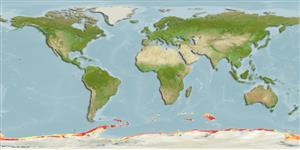Environment: milieu / climate zone / depth range / distribution range
Ecología
marino demersal; oceanodromo (Ref. 51243); rango de profundidad 1 - 1010 m (Ref. 114491). Polar; 45°S - 78°S, 180°W - 180°E
Circumpolar south of Antarctic Polar Front, but not found in Ross Sea; adults only in higher latitudes (South Orkneys, South Shetlands, Peter Island) and south of the Weddell-Scotia confluence, but adults and juveniles in the region of South Sandwich I, South Georgia and Bouvet. Reported from off the Cape, South Africa and from 43°17'S, 48°55'E (Ref. 4066).
Length at first maturity / Tamaño / Peso / Age
Maturity: Lm 7.4 range ? - ? cm
Max length : 11.5 cm SL macho / no sexado; (Ref. 114491); 10.3 cm SL (female); peso máximo publicado: 15.00 g (Ref. 124149); edad máxima reportada: 4 años (Ref. 94119)
Espinas dorsales (total): 0; Radios blandos dorsales (total): 14-16; Espinas anales 0; Radios blandos anales: 19 - 22
Oceanic and mesopelagic, found in the upper 100 m south of the Antarctic Polar Front but deeper northwards (Ref. 4066). Adults take more euphausiids and also prey upon polychaetes. The diet of juveniles of less than 6 cm SL consists mainly of copepods, with some euphausiids and hyperiids. Possibly the most common myctophid occurring south of the Antarctic Polar Front.
Life cycle and mating behavior
Madurez | Reproducción | Puesta | Huevos | Fecundidad | Larva
Hulley, P.A., 1990. Myctophidae. p. 146-178. In O. Gon and P.C. Heemstra (eds.) Fishes of the Southern Ocean. J.L.B. Smith Institute of Ichthyology, Grahamstown, South Africa. (Ref. 5182)
IUCN Red List Status (Ref. 130435)
Threat to humans
Harmless
Human uses
Warning: mysqli::__construct(): (HY000/1040): Too many connections in /var/www/html/includes/func_getlabel.php on line 46
Can't connect to MySQL database (fbapp). Errorcode: Too many connections
